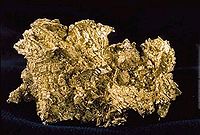
Photo from wikipedia
Abstract We examine the volatility spillovers and hedging characteristics between four major precious metals futures (gold, palladium, platinum, and silver) and seven major currencies (Australian dollar, British pound, Canadian dollar,… Click to show full abstract
Abstract We examine the volatility spillovers and hedging characteristics between four major precious metals futures (gold, palladium, platinum, and silver) and seven major currencies (Australian dollar, British pound, Canadian dollar, Chinese yuan, Euro, Japanese yen, and Swiss franc) at three time horizons (short term, intermediate term, and long term). We draw our empirical results using the index methods of Diebold and Yilmaz, 2012 , Diebold and Yilmaz, 2014 and Barunik and Křehlik (2018) . The results show that the precious metals, except for gold, have the largest spillovers on the Australian dollar and Canadian dollar and receive the largest spillovers from these currencies for all the time horizons. In addition, with the exception of gold, the smallest spillovers from the precious metals are exerted on the Japanese yen and Chinese yuan and these currencies have the smallest spillovers to the precious metals. The Japanese yen and Chinese yuan act primarily as spillover receivers, whereas the other currencies act as both spillover transmitters and receivers in different time periods. The spillovers for most of the pairs are asymmetric for all the time horizons, are more pronounced in the short term, and noticeably increase during times of financial and economic uncertainty. Finally, adding precious metal futures contracts to currency portfolios provides diversification and hedging advantages, with hedging effectiveness higher in the short term than in the intermediate and long terms.
Journal Title: International Review of Financial Analysis
Year Published: 2021
Link to full text (if available)
Share on Social Media: Sign Up to like & get
recommendations!